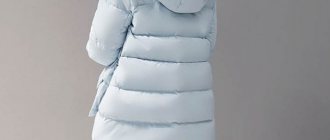How to conveniently arrange things in a closet?
Your “Nothing to Wear” has nowhere to put it!
A phrase that every husband will subscribe to.
I have written more than one useful article about wardrobe revision and analysis! Today we’ll talk about whether order in the closet is achievable and exactly how you can arrange and hang all things and accessories on shelves and hangers so that all the necessary clothes are always at hand!
Every girl is familiar with Narnia. And he knows exactly where this very Narnia is. In her closet with clothes. That’s for sure - a magical world in which it is unclear what goes where and where everything is. In the most severe cases, unable to withstand the pressure of magic from within, the doors of the closet fall off or the shelves collapse. This happened to me with my shoe closet.
How many times when going through your wardrobe do you say: “Oh, what a cute blouse-skirt-sandals! Wow, I completely forgot about them!” Or, having acquired another new thing, you remember that somewhere in the depths... on the farthest shelf... the new is the well-forgotten old, yeah. Now in duplicate.
Interesting packaging ideas
But folding it beautifully is not the end of the matter, unfortunately. Now you need to package it beautifully, for this you can use:
- wrapping paper;
- a beautiful package - buy a gift bag and, so to speak, present a gift in a classic style;
- box;
- envelope;
- foil;
- cling film;
- into any other material that you have at hand.
Let's look at original ways to pack sweatshirts, hoodies, and sweatshirts.
Take a jacket, roll it up, wrap it in cling film so as not to stain it, and pack it in paper, tie it with a ribbon, and you can also add a signet. To do this, just take plasticine, squeeze out the stamp you need and set it to dry. Fry it a little, and that’s it – the letter is ready.
Gift envelope
Take your sweatshirt and place it in the center of the paper (keep in mind that it should be 2 times larger than the item itself). Fold the edges so that you get a neat envelope. You can cut off the excess, you can decorate such an envelope with anything, depending on the interests of the birthday person. These could be joint photographs, decorative napkins, various bows made of ribbons and threads.
You can revive this envelope by adding various details (for example, teeth and eyes, make a monster or a glamorous girl by adding hair and eyes).
Everything your imagination allows.
Envelope shirt
Perfect for packing a men's gift. You need to take thick paper (thick parchment is perfect), saturated colored colored paper, an empty box (we will make a layout around it), glue.
We wrap the box with paper, glue the edges, glue the bottom, and pull out the box. We put our jumper inside, connect the edges at the top and twist it a little. We fix it with glue, you can put it on a button or button. Next, take colored paper - cut out a tie, cuffs and glue it to our envelope. And we have stylish gift packaging ready.
You can twist a flower from a jacket of not very dense material. To do this, you need to tighten the thread approximately in the middle, twist the upper part, while holding it with your fingers, forming a rose, and simply twist the lower part into the so-called “sprout”.
This is how you can easily and quickly pack clothes for a gift for any occasion.
See the video below for a gift wrapping option.
VISIBLE SPOT
The saying “out of sight, out of mind” also affects memory when it comes to wardrobe. If you don't see a thing, then, as a rule, you don't remember it. And the result is the same sets of things that are constantly in sight. Boring. All you have to do is arrange things so that they can be seen. This, in my opinion, is the main purpose of organizing your wardrobe.
A clothing dump can bring another unpleasant surprise: suppose you suddenly remember a beautiful cardigan that hasn’t been worn for a hundred years. And we decided to take him for a walk. And when they took it out of the deposits, they discovered that it was all crumpled and there were no buttons. It’s good if you have time to put it in order and a button, but what if not? In this case, the item is very often sent back to the pile, where it will lie until it is thrown away or given away. And you could wear it with pleasure.
Do you think this is a rather bleak picture?
So, let's begin to restore world harmony within the framework of a single wardrobe. First you need to determine in what position each item will be stored. Will it hang on a hanger, put it on a shelf, or be stored in a box? The storage method depends, first of all, on the purpose of the item, the type of material and frequency of use.
Useful tips
To learn how to fold clothes neatly, you will need to properly prepare them using a few helpful tips.
- Clothes must be washed in accordance with the care recommendations: for products made from natural fabrics (linen, cotton) the recommended water temperature is 60°, and delicate materials, including wool, at 30°.
- Before putting clothes in the closet, it is recommended to carefully iron them and hang them on hangers. This way you will be able to avoid creases during long-term storage and repeated ironing.
- In addition, it is recommended to sort clothes, for example, by temperature, color, etc.
- When stored horizontally, in the form of stacks, the optimal number of items in each should not exceed 3. This will help you quickly find the necessary wardrobe item without disturbing the order on the shelf.
- If space allows, it is recommended to store things in drawers, vertically. The basic rule is to give the folded clothes a rectangular shape, the height of which does not exceed the size of the drawer. This will create order and harmony in your wardrobe or chest of drawers.
- We advise you to wipe the dust on the shelves and cabinet doors every week.
- Carry out an inspection of clothing at least once a season.
- And in order for it to maintain freshness, many housewives use natural flavors. Some of them are installed directly on the shelf, others are placed on hangers.
- To make your own fragrances, we recommend using small pieces of soap with your favorite unobtrusive scent, placing them between your clothes.
HANGERS
Now let’s take hold of the hangers and throw out all the wire misunderstandings, slanted planks and plastic monsters 3 sizes too large that have crept into your closet. This trinity can cause irreparable damage to delicate and thin tissues or skin. Wire hangers are needed to bring clothes from the dry cleaner or workshop. All. You cannot store clothes on them! Under its own weight, the fabric stretches, and the thin frame of the hanger is very easily deformed. And, once again taking out your favorite jacket, you may find “ears” on the shoulders or sleeves (if the hanger is the wrong size), similar in shape to the ugly bubbles of sweatpants, only small. I'm not even talking about the exquisitely colored rust stains on a light jacket, for example.
Option two - wooden hangers. Just please, not the creepy two-plank designs that remember your mother’s prom dress. But wide ones with rounded ends are what you need. The only thing is that things can easily slip off from patent-leather hangers, so fasten the buttons. The advantages of such hangers are at the same time their disadvantage: they are solid, beautiful, take up a lot of space in the closet and are expensive. Such a Bentley among hangers. This category, very beautiful and very expensive, includes hangers covered with leather.
If functionality is most important to you, then welcome to the world of plastic hangers. But not powerful cast monsters on which you can hang knight's armor, and nothing will survive. The crossbar next to the closet will probably break. Plastic hangers are very convenient for putting things in order. Lightweight, functional, for delicate thin fabrics there are silicone pads so that silk or cambric does not slip off.
The most ideal, in my experience, are vinyl coated hangers. If anyone is sad about the thinness of wire, this is the place for you. They are almost as thin, but they no longer pull clothes because of their size, a lot of them can fit in a closet, and the special coating, that same vinyl (yes, it turns out that not only records are made from it), does not allow them to slip and become deformed even the thinnest and most delicate fabrics.
A general rule for all hangers: they should be the right size for you! It is necessary. Too large will cause bubbles on the sleeves, and too small will cause bubbles on the shoulders.
It is also recommended that all hangers be the same, so that when you open the closet, you see an orderly row of hanging clothes, and not sleeves and shoulders sticking out at random.
A few words about fabric hangers: they look very cute, ideal for thin blouses, but take up a lot of space. One way out: take out one or two shelves in a closet with shelves, nail a crossbar in the resulting space and hang soft hangers with blouses on it.
A general rule for everyone: hangers should be smooth, with recesses for straps or special loops for skirts or dresses. Some models have a crossbar or tucks for trousers. Whether you use them or not is up to you. Just keep in mind that in this position the trousers may wrinkle.
If ironing is not so scary for you, then you can save space by purchasing these hangers for your trousers.
What is not recommended to be stored on hangers is knitwear, especially thin ones, woolen sweaters, cardigans and other fabrics that can deform under their own weight. It is best to fold them in neat piles, sorted by density.
A little trick: alternate in one pile, say, sweaters or tops, bright and dark. This way they will be more noticeable and will not merge with each other. The same stacks are convenient for storing jeans.
Some people prefer to store knitted items vertically in a chest of drawers or drawers, as the Japanese do. To learn more about this method, read Marie Kondo's book The Magic of Tidying Up. But let me note right away that this method is not suitable for everyone. Didn't suit me. Things get very wrinkled 
And this is a life hack for girls who especially like to plan everything. I learned about it from my basic course student, who approached all tasks very responsibly.
After a total revision of her wardrobe, she photographed ALL her looks, sent them to me, we adjusted them a little, and then she just took and hung her photos on the inside of the closet doors. She no longer faced the question of “what to wear.” 
I think it's brilliant!
Gift Wrapping Ideas
A natural wool jumper or jacket is nice to give and receive as a gift.
Giving a present effectively is also an important matter. Several ways to gift a sweater or jacket:
- The classic option is to fold the item face up, wrap it in wrapping paper, and tie it with tape. Newspaper or tissue wrapping paper tied with canvas thread looks elegant and discreet.
- Roll the sweater into a neat roll and tie with a wide ribbon. The retainer can be decorated with small accessories, and a card with wishes to the recipient can be placed under it.
- Pack in a cardboard box, decorate with wrapping paper, ribbons, and decor. In this form, it is safe to send a gift by mail or courier, and receiving holiday parcels is especially pleasant.
- Wrap the rolled product on top with colored paper and tie it on both sides with ribbons like a candy wrapper. A sweater folded this way is a great gift for children.
Proper storage is especially important for woolen and knitted items. They are very sensitive to moisture, temperature changes, and friction against other items in the wardrobe
Therefore, it is useful to learn simple folding techniques as they can significantly extend the life of your clothes.
BAGS: HOW TO STORE IN THE CLOSET?
In the lower (or upper) part of the cabinet, in special cases, stuffed with paper inside. This way, creases do not form on them, and the surface does not get dirty.
Of course, there is not always enough space in the closet for bags. There will be much more space for them in a full-fledged dressing room.
Small bags and crossbody can be conveniently hung on hooks. You can use a regular scarf hanger or special hangers, like in the picture on the right.
Or order such hanging organizers on AliExpress 
Belts, scarves, shawls. Welcome to IKEA! This is truly a paradise for lovers of order. Hangers, rails, boxes for accessories, storage modules, drawers with dividers - a paradise for those who like to organize everything.
How to fold a sweater
Knitted sweaters are placed on hangers or on shelves reserved for warm tops in the dressing room or in a pencil case, chest of drawers, or closet. A sweater on a hanger stretches and sag, so it is better to fold it carefully. At the same time, you need to put the item away nicely and compactly in a closet, chest of drawers or suitcase so that it does not become wrinkled or deformed, since there is often no time or opportunity for ironing.
For a quick and high-quality process of cleaning your wardrobe, there is an auxiliary item, which is popularly called a fold. It takes up a lot of space, but eliminates the hassle. If you don’t have such a device, you should try a few simple methods.
The items at hand that will be needed are a solid, flat base, cardboard or a magazine. The surface for folding needs to be wide enough so that the jacket lies completely on it and does not rest against the sides or protrusions with the sleeve. A mandatory requirement for a plane is smoothness. The presence of unevenness prevents the correct design of clothing.
Like in a store
Cleaning your closet is quite easy to automate thanks to this method. Initially, you need to place the clothing horizontally on a straight surface with the right side facing up. All additional elements of the product are fastened and straightened.
Then you should roll the sleeves towards the center. They should not lie on top of each other, but only touch. The next step is to bend the lower part back in line with the shoulders. The resulting rectangle is turned over to the other side and folded three times, starting from the bottom edge. It turns out to be a compact square.
This technique is used by employees of shops, supermarkets and boutiques to give things a presentable, advertising look and save space on shelves.
When getting ready for a celebration, people often discover that the gift is not wrapped. Sweatshirts and blouses purchased or knitted with your own hands can be decorated beautifully and quickly. To do this carefully, just follow these recommendations:
- Place and level the item on the surface.
- Bending the product near the shoulder, fold it in half. The second part of the clothing is folded identically. The jacket should take the shape of a triangle.
- Fold the bottom about 15 cm. The size of the fold depends on the volume of the package.
- Lay the top half so that the bottom part does not protrude from under the shoulder line.
- All that remains is to put the gift in the box, packaging and go to the holiday.
Thanks to this method, the gift will be quickly and correctly prepared for delivery. There will be no need to iron or hang clothes to straighten them. The jacket can be worn after presentation.
Another gift option
You can perform just a few simple steps, and the donated garment will look neat in the packaging and will not wrinkle. To complete the task, 5-10 minutes of free time is enough. To simplify the manipulation, use a thick A4 sheet, newspaper or magazine page.
First you need to place the sweater face down on the table. Place the prepared insert on the back, slightly below the neckline. It should be at an equal distance from the edges of the sweater. After this, both sides of the item are bent inward, until the middle of the insert. The sleeves can be removed in any convenient way: you can roll them into an accordion or leave them extended. All that remains is to carefully remove the cardboard or magazine.
Today, many stores provide professional services for the careful packaging of any gift by staff. But there is nothing more enjoyable than doing it yourself. With a little practice, the whole process will take no more than 2 minutes.
There is always limited space for things in a suitcase or bag. You need to be smart and dexterous to take all your favorite sweaters with you on the road. The technique of rolling things into a roll will help with this desire. Such a package looks not only neat, but also less voluminous. At the same time, your vacation will not be overshadowed by ironing.
- You will need a flat surface without sharp corners that can damage clothing.
- We lay out the product from yarn or knitwear. If there are buttons, they must be fastened.
- Fold the sleeves to the back.
- We take the bottom of the sweater and roll the item with both hands, heading towards the collar.
- The final point is to compactly fold the resulting scroll into a suitcase.
To prevent the rolls from unwinding and keep them compact, you should get small rubber bands. Both stationery ones and those used for packaging banknotes are suitable.
HOW TO HANG SCARFS?
The main task is still the same: they must be visible, so boxes and crates are not suitable for this purpose; a moth will get to the scarf lying at the bottom of the box much faster than you. So, either in a stack on a shelf, or, if there are not many of them, hang them on special structures, of which there are many on sale.
Tips and tricks
Care and proper storage of linen extends their service life. Careful placement of tension products helps prolong the life of the elastic and avoid stretching it.
Violation of these rules will result in aging of the material, unpleasant appearance and smell. According to the advice of experienced housewives, you need to do this:
- store each type of linen on separate shelves, neatly folded;
- terry, flannel, soft sets should be stored separately;
- colored sets are stored separately from plain sets;
- the material must breathe, it is forbidden to keep it in plastic bags;
- bed linen is refreshed every 10 days;
- try not to overdry the material;
- after washing, iron at the specified temperature parameters;
- after ironing, the products must cool for 2 hours;
- when purchasing sets, it is worth purchasing 2-3 at the same time, then the parts will be interchangeable, which will extend their service life.
Several sets can be placed inside a pillowcase - this is convenient and also neat, taking up minimal space on the shelf.
Such simple rules should become a habit. They will reduce cleaning time and extend the life of your favorite things and bedding. Each styling method is good in its own way; the housewife must choose which one she likes best. By showing patience and perseverance during the first steps, gradually this work will become automatic and pleasant.
Share link:
BELTS AND TIES
This is where the delimiter module comes in handy. Their cells can accommodate the entire collection. Roll into a ring, not too tightly, with the buckle facing outward to avoid creases. And each one in a separate cell. Wide ones, if space allows, can be laid out flat, and corset ones can be placed vertically.
Another option is to hang them on special hangers. A belt hanger can be attached to a closet door, provided that the belts do not touch clothing (otherwise, hello, puffs!)
How to fold a sweatshirt
This item of clothing is a warm knitted jacket with a sports cut, sewn on a fleece or footer basis. Sweatshirts provide excellent warmth in the cool season; their voluminous shape retains body heat well. To prevent things from getting wrinkled in the closet, you need to fold them correctly and neatly. The method of folding the sweatshirt will directly depend on the presence of a hood.
Store way of packing things
How to fold a sweatshirt without a hood
As a rule, such sweatshirts are called sweatshirts. You can fold them like regular knitted sweaters using the method above.
How to fold a hoodie
The product will look compact and neat on a shelf in a closet if it is folded in the following way:
- Place the sweatshirt face up on a flat surface (table, bed or sofa).
- Fold the hood along the shoulder line and pull the sleeves along the side seam.
- In the resulting rectangle, visually draw a line directly in the center of the product.
- Bend the right side so that the edge together with the sleeve touches the middle of the sweatshirt, repeat the action for the left side.
- Fold the tails of the clothing a third towards the middle, cover with the remaining top part of the sweatshirt.
You can compactly fold the sweatshirt directly into the hood, making it more convenient to transport it in a backpack or sports bag:
- Lay the item of clothing on the table facing you, straighten the folds, sleeves and hood of the item.
- Visually draw a line from the middle of the right shoulder seam to the bottom of the sweatshirt. Along this line, fold the clothes first on the right and then on the left side. The sleeves are laid like an accordion on top of the folded back.
- Roll the sweatshirt, starting from the bottom, into a tight roll and place it in the hood, tighten the lacing.
Sweatshirt folded inside its own hood
UNDERWEAR AND STOCKINGS
For stockings and socks, dividers will again come in handy. Place one of these in a drawer of the chest of drawers and the socks living there will no longer resemble a multi-colored lump of who knows what it’s made of. It is very advisable to arrange stockings and socks according to “sameness”, so that in search of the twin brother of one stocking you do not empty out the entire drawer.
With linen everything is simple. Fold the bras one cup into the other, you can put panties in the top of the set folded in this way, put the next set in the resulting structure, and so on until you run out. It is convenient to store individual items in boxes without a top, so they do not spread throughout the closet or chest of drawers.
Tips and tricks
The main rule to ensure high-quality folding of a sweater is to use a hard surface. Be sure to iron the item before putting it in the closet. If you decide to wrap the item around a hanger, make sure that the corners of the hanger do not create untidy bumps in the fabric.
How to fold a jacket with sleeves and a hood
Mom showed me how to fold things: now my hoodies and sweaters are always wrinkle-free
How to Fold a T-Shirt Properly Starting at the waistband, roll the pants up to the legs, then pull the space in the remaining pant leg inside out and tuck the remaining jeans inside to make a roll.
How to fold a jacket with sleeves and a hood How to fold a jacket with a hood beautifully
How to properly store a hooded sweater: Fold your items carefully and go through your clothes regularly. Every month, wipe the dust on the shelves and walls inside the wardrobe. Ventilate the closet twice a year. To do this, take things out, wash the inside of the furniture and leave them with the doors open for a few things. This will keep things fresh and help get rid of the smell of sweat, perfume, and stale clothes that have been stored for a long time.
How to fold a jacket with sleeves and a hood
SHOES
There are two options: either in original boxes, with photographs pasted on them (what a pity that Polaroids are out of circulation).
Or buy boxes with transparent windows from IKEA.
Because the principle works with shoes like nothing else: if it is not visible, then it is not there.
And rummaging through all the boxes in search of the right pair is not a pleasant task. For a long life of your favorite shoes, learn the rule: if you decide to put them in a box, clean them first. And stuff it with paper to avoid deformation.
Packing a suitcase
First of all, you need to decide how long the trip will be and how spacious the bag for things will be needed.
If you don't have much luggage, it's better to choose a small suitcase.
The main rule is that you should not take too much.
| View | Size (inches) | Height (cm) | Width(cm) | Depth (cm) |
| S | 20 | 54 | 40 | 22 |
| M | 24 | 65 | 42 | 24 |
| L | 28 | 72 | 44 | 26 |
The second important factor to consider when packing luggage is where the person will be going. Before traveling, it is recommended to check the weather forecast at your destination so as not to take clothes that are clearly not useful.
The main rule is that you should not take too much.
A week before the trip, it is recommended to make a list of things you need for the trip.
Many things may not be needed, but they will significantly add weight to the bag and at the airport before boarding the plane you will have to pay extra for the excess.
It is worth trying to fill the voids formed in the suitcase as much as possible - this saves space and ensures the safety of things while traveling.
Anything heavy should be placed at the very bottom. If possible, you should take clothes made from wrinkle-resistant materials.
- Make a list. This will help you not to forget anything. When arranging your travel bag, visualize the available space. Perhaps some things can be replaced with less voluminous ones.
- Combine sets of things in advance. Choose clothes so that they match the rest of your wardrobe as much as possible.
- Don't take things just in case. Check the weather forecast in advance to ensure you pack the right accessories and wardrobe items.
- You shouldn’t stock up on things for future use that you can easily buy upon arrival. We are talking about soap, hygiene items, and a toothbrush.
- The bottom of the suitcase should be occupied by bulky items and those wardrobe items that you will not need soon. Place toiletries and clothes you plan to change into during your trip on top.
Rolled clothes can be laid out in any order. However, it will be more convenient for you if you use organizers. Organizing each type of clothing into its own section will help you create order and help you find a fresh T-shirt in seconds.
You can use the old way of packing things - using papyrus paper and film. This will ensure compactness, and most importantly, the clothes will practically not wrinkle.
DECORATIONS
For jewelry and jewelry, it is most convenient to splurge on a special chest of drawers or dividers with a larger number of sections. The more sections, the better!
Necklaces and chains can be hung on hooks; when lying down, they happily and quickly get mixed up with each other.
And glasses can also be hung on a hanger!
OUTERWEAR
The problem with it is that half the time it is worn very actively, and the other half it is not taken out of the closet at all. Therefore, before putting it in the closet (fur - only in a closet or in a fabric case, it will “suffocate” in a plastic bag) - be sure to clean it and put in an anti-moth agent. Don't be afraid, they no longer smell like old mothballs. In general, in order to avoid a colony of these winged friends of humans, often go through clothes that have not been worn for a long time and do not forget to periodically change the tablets.
To be honest, organizing your wardrobe takes a lot of time and effort. But the result is visible immediately, you can use it for a long time, and for the titanic work done, you can treat yourself to, say, a new blouse. After all, you now know for sure that you don’t have exactly this one yet! 
Closet organization steps
So, on your day off, when you are cleaning the house, include another important task in your program - organizing things in the closet. It will be enough to perform this procedure once every six months. By following step by step the main stages of correctly arranging things in your wardrobe, you will understand that it is simple and pleasant.
Empty the closet
First of all, completely empty the closet by taking out all your things. Thus, firstly, you can visually assess the number of your items and the size of your wardrobe. This will help you think about how you can rationally use each shelf.
Secondly, this stage will help you avoid thoughtless purchases. Having sorted out your closet, you will see which things are in abundance and which you need to buy.
Thirdly, after emptying your closet, you can measure the dimensions of the shelves in the closet. Today, stores offer a large selection of clothing and underwear storage accessories that fit any layout and design. Drawers, baskets and drawers for storing things and accessories will help save space. And the clothing placement strategy will become more thoughtful and clear. Drawer or shelf dividers are also equally effective.
Clean the inside of the cabinet
Before you start putting things on the shelves, be sure to wash the inside of the closet. A sponge moistened with water or surface cleaner is suitable for this.
This procedure is simply necessary. After all, you don't want your clean clothes to be stored in a place where dust accumulates.
Separate your clothes
Once you have emptied your closet, start separating your clothes according to the following principle:
- The things you wear most often;
- Things you don't wear often;
- Things you don't wear for six months.
After which, the clothes included in the first two points should be divided into the following categories:
- Everyday things;
- Formal items, work wear;
- Evening clothes for going out.
Try on all the clothes
After you have divided all the clothes into piles, you should try on each item. Why is this necessary? It is at this stage that you will discover that some things are already old or do not suit you. In this case, worn-out clothes should be recycled, and those that do not fit can be donated.
Also, while trying on clothes, you will understand that some things are no longer “to your liking.” So why keep them if you're not going to wear them anytime soon anyway? It’s worth thinking about this and perhaps putting them in the pile of things that you don’t wear for six months. On the other hand, you may find an outfit that you haven't worn for a long time, but it ends up being a great option for everyday wear today.
Once you've sorted your clothes into categories and gotten rid of those you don't plan to wear, you can move on to the next step.
Use all the shelves
Before you start putting things away, think carefully about where you will put your clothes, underwear, shoes and accessories. Use all the available space: shelves, drawers and storage boxes. As well as dividers for storing things and place them so that they are visible at first glance. To help you find it faster, you can make small notes to indicate what each storage container contains.
To store underwear, you need to allocate separate shelves in the closet, or you can add a chest of drawers or a small drawer to the room.
Time to unpack
The clothes you wear most often should be on shelves that are easy to access as soon as you open the closet. Formal and evening wear, which are rarely used, should be placed on other shelves, and be in second place in terms of availability. Expensive items should be stored in special cases, protecting them from dust and snags.
Repeat the same operation with seasonal items. So, during hot weather, winter clothes should be hidden in boxes or in vacuum bags. And then put it in the far corner of the closet to free up as much space as possible for summer clothes. This rule is very important for perfect wardrobe organization, especially for a closet with limited space.
Another secret to properly organizing your closet is arranging clothes into sets. For example, you can hang a suit next to a shirt, or jeans next to a T-shirt that you usually wear together. Thus, you can choose specific clothes for work or for a walk in one motion, saving time.
And the final action that we propose is more concerned with the aesthetic appearance of your wardrobe. Organize or hang clothes by color. This will make your closet more organized, which will help you find what you are looking for faster. And if you choose hangers of the same colors, the visual effect will be even better.











